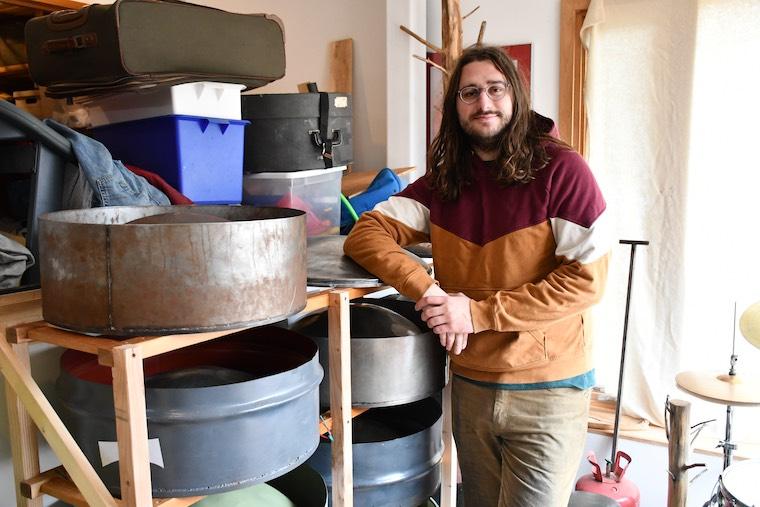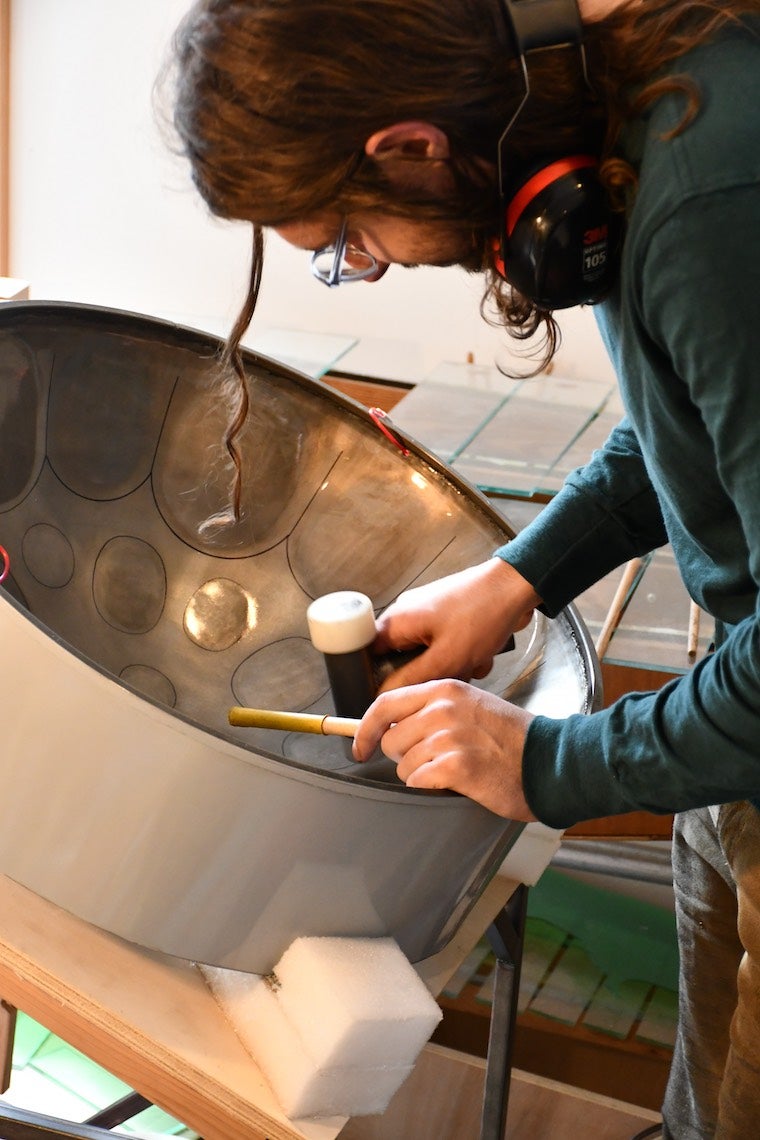Maker, Musician and Steel Pan Tuner: Noah Sanderson ’16
June 5, 2019
Andrea Wang ’19

Noah Sanderson ’16 in his pan tuning workshop, which doubles as a percussion room. Sanderson started getting serious about steel pan while at Oberlin.
Photo credit: Heidi Armster
In addition to studying jazz piano performance at Oberlin, Sanderson was part of OSteel, Oberlin’s steel pan band. Steel pans, also known as steel drums, are a pitched percussion instrument originating from Trinidad and Tobago.
The lifelong tinkerer and musician started getting serious about the instrument while at Oberlin, and currently makes and tunes steel pans full time.
How did you get into tuning and making steel pans?
In grade school, I used to take lessons at a percussion studio, and they made us all play in a steel band. I didn’t like it at first, but gradually warmed up to it. It wasn’t until Oberlin that I became fairly obsessed. I’ve always liked to make homemade instruments: lots of PVC and cardboard flutes in middle school, then in high school I started making different types of mallet instruments out of wood, metal, and glass—including a glass marimba . Making steel pans seemed to be the perfect thing for me to get into, but I never seriously considered it, mostly because I’d been told it takes years of learning. I think deep down, it actually bothered me that I knew nothing about steelpan making. Fast forward to last year, when I finally had the time and the opportunity, I decided to go for it.
What are some of the best things about your work?
When I finish a pan, I’ll often think, "Whoa, this instrument that has all these notes on it and sounds musical was recently just a flat piece of steel." It’s a nice feeling to have something tangible that I created, especially now that I sell pans to musicians who are playing and enjoying them as well. I also like the control I have over the construction of the instrument, and the different sounds that result from that. Now that I’m doing all this tuning and building, I can experiment with different notes, layouts, placements, and timbres that I would have never thought to do before.

Photo by Heidi Armster
How did your Oberlin experiences help shape your interests?
It was only after joining Oberlin Steel, the steel band on campus, that I really started learning how to play the instrument better, coming into the panyard whenever I had free time. I spent the most time there out of any other place on campus. There was something very comforting and communal about a room full of steel pans always ready to be played. I also started listening to a lot of steelband recordings, especially those of the great bands of Trinidad, where the steelpan was invented and developed. Lots of steel bands have this swing that really captivated me and made me want to dance more than any other music I’ve listened to.
How do you build a steel pan?
All pans start with a circular piece of sheet steel stretched into a bowl shape, traditionally made from 55-gallon steel barrels. Historically, this was done by a combination of sledge hammers or steel balls. After the pan is sunk into a bowl shape, I mark out the notes using templates, and stretch down the metal in between the notes so that the notes appear to "pop" up as convex bulges. After that, I fire the pan, which evens out tensions in the steel and makes the pan ring longer and brighter when tuned. Finally, tuning: using hammers and wedges, I loosen up the notes and adjust their shape to vibrate to a set of pitches. This takes quite a while, requiring many passes on all the notes for the pan to start sounding good.
In the future, Noah plans to experiment with more unconventional versions of the instrument, such as steel pans made of different types of metal or of different shapes and sizes.
You may also like…
Josh Nolan Named Vice President, General Counsel, and Secretary at Oberlin
Distinguished attorney brings extensive experience in higher education law.
Learning by Teaching: Oberlin Students Share Global Music with Young Learners
College and Conservatory students in PACE 103 prepare local children for an immersive community concert at Oberlin.
Nuiko Wadden ’02 Joins Oberlin Conservatory Faculty as Assistant Professor of Harp
The versatile musician brings extensive opera, orchestral, and contemporary music experience to her role


